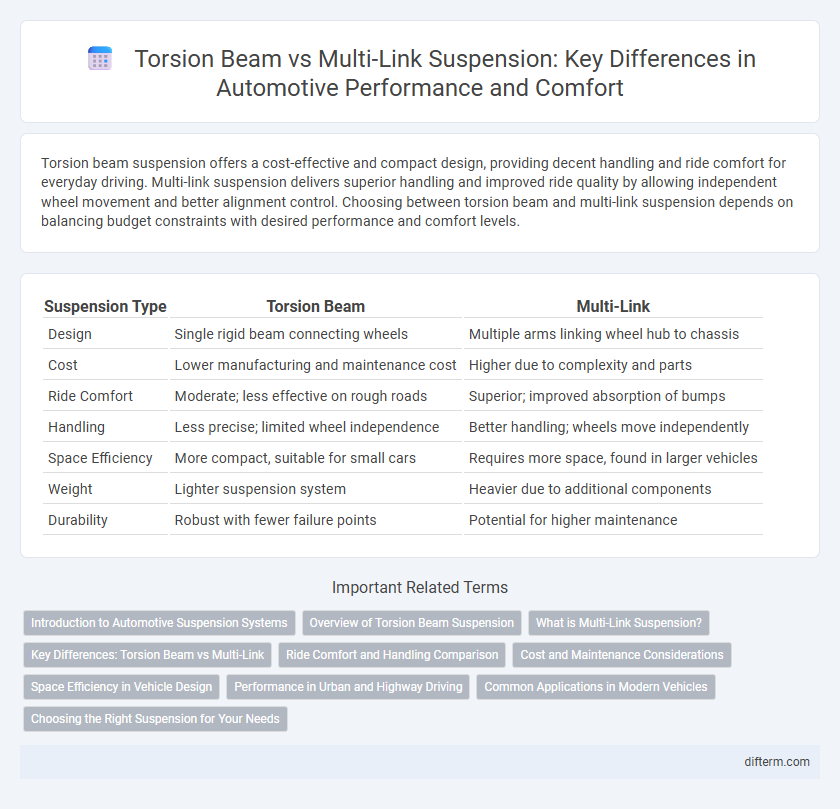Torsion beam suspension offers a cost-effective and compact design, providing decent handling and ride comfort for everyday driving. Multi-link suspension delivers superior handling and improved ride quality by allowing independent wheel movement and better alignment control. Choosing between torsion beam and multi-link suspension depends on balancing budget constraints with desired performance and comfort levels.
Table of Comparison
| Suspension Type | Torsion Beam | Multi-Link |
|---|---|---|
| Design | Single rigid beam connecting wheels | Multiple arms linking wheel hub to chassis |
| Cost | Lower manufacturing and maintenance cost | Higher due to complexity and parts |
| Ride Comfort | Moderate; less effective on rough roads | Superior; improved absorption of bumps |
| Handling | Less precise; limited wheel independence | Better handling; wheels move independently |
| Space Efficiency | More compact, suitable for small cars | Requires more space, found in larger vehicles |
| Weight | Lighter suspension system | Heavier due to additional components |
| Durability | Robust with fewer failure points | Potential for higher maintenance |
Introduction to Automotive Suspension Systems
Torsion beam suspension offers a simple, cost-effective rear suspension design commonly found in compact cars, providing reliable handling with limited space requirements. Multi-link suspension systems use multiple arms and links to independently control wheel movement, enhancing ride comfort, stability, and cornering performance in higher-end vehicles. Understanding these fundamental suspension types is crucial for optimizing vehicle dynamics, safety, and overall driving experience in automotive engineering.
Overview of Torsion Beam Suspension
Torsion beam suspension features a simple, cost-effective design that connects the rear wheels with a single beam acting as a torsion spring, providing moderate ride comfort and handling stability. It is commonly used in compact and economy vehicles due to its lightweight structure and ease of manufacturing, which reduces production costs. While it offers less independent wheel movement compared to multi-link suspension, its durability and compact footprint make it ideal for maximizing rear cargo space.
What is Multi-Link Suspension?
Multi-link suspension is a sophisticated automotive suspension system that uses multiple arms and links to independently control each wheel's movement, enhancing ride comfort and handling precision. This design allows for better adaptability to varying road conditions and reduces tire wear by maintaining optimal wheel alignment during cornering. Commonly found in modern vehicles, multi-link suspensions offer superior performance compared to simpler setups like torsion beam suspensions.
Key Differences: Torsion Beam vs Multi-Link
Torsion beam suspension features a simple, cost-effective design with a single beam connecting the rear wheels, offering reduced weight and compact packaging ideal for economy cars. Multi-link suspension employs multiple arms and links that allow independent wheel movement, delivering superior ride comfort, handling precision, and improved traction in performance and luxury vehicles. The key differences lie in complexity, cost, spatial requirements, and dynamic response, with torsion beams favoring durability and affordability, while multi-link systems prioritize enhanced handling and adaptability.
Ride Comfort and Handling Comparison
Torsion beam suspension offers a compact design with lower production costs but typically provides less ride comfort and handling precision compared to multi-link suspension systems. Multi-link suspension enhances ride quality by independently controlling wheel movement, resulting in improved handling stability, reduced road noise, and superior shock absorption. Automakers often prefer multi-link setups for performance and luxury vehicles due to their ability to balance comfort and dynamic driving characteristics effectively.
Cost and Maintenance Considerations
Torsion beam suspension offers a cost-effective design with lower manufacturing and maintenance expenses due to its simpler architecture and fewer moving components. Multi-link suspension, while providing superior handling and ride comfort, incurs higher costs in both initial production and ongoing maintenance because of its complex setup and increased number of parts. Choosing between the two systems often depends on balancing budget constraints with desired vehicle performance and long-term maintenance commitments.
Space Efficiency in Vehicle Design
Torsion beam suspensions offer superior space efficiency by occupying less lateral and longitudinal space, enabling designers to maximize trunk capacity and interior room in compact vehicles. Multi-link suspensions, while providing enhanced handling and ride comfort, require more space due to their complex geometry and multiple control arms, which can limit packaging flexibility in smaller cars. Prioritizing space efficiency in vehicle design often leads manufacturers of compact and subcompact models to choose torsion beam setups for optimized cabin and cargo volume.
Performance in Urban and Highway Driving
Torsion beam suspension offers a simpler, more cost-effective design with adequate performance for urban driving, providing stability and minimal maintenance in stop-and-go traffic. Multi-link suspension excels in highway driving by delivering superior handling, enhanced ride comfort, and improved wheel control during high-speed maneuvers. The multi-link system's ability to independently manage each wheel's movement results in better traction and reduced body roll compared to the torsion beam setup.
Common Applications in Modern Vehicles
Torsion beam suspension is commonly used in compact cars and budget-friendly models due to its cost-effectiveness and space-saving design, providing adequate handling and ride comfort for everyday driving. Multi-link suspension systems are widely adopted in mid-range to luxury vehicles and performance cars, offering superior wheel control, improved handling, and enhanced ride quality by allowing independent wheel movement. Manufacturers often select torsion beam for rear-wheel setups in economy cars, while multi-link systems are preferred for rear suspensions in SUVs and high-end sedans to meet demanding performance and comfort standards.
Choosing the Right Suspension for Your Needs
Selecting the optimal suspension between torsion beam and multi-link systems depends on balancing cost, handling, and comfort requirements. Torsion beam suspensions offer affordability and compact design, making them suitable for budget-friendly vehicles and city driving. Multi-link suspensions provide superior ride quality and enhanced handling dynamics, ideal for performance-oriented cars and uneven road conditions.
torsion beam vs multi-link suspension Infographic

 difterm.com
difterm.com